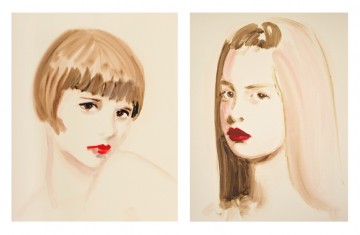New Art from Annie Kevans
Annie Kevans hit the Art world straight out of Central St.Martins with the sale to Saatchi of her acclaimed and controversial series of portrayals of dictators as ‘innocent’ children, ‘Boys’. Never afraid to confront and challenge the viewer, she has gone on and into major exhibitions, galleries and collectors around the world, which shows the quality and skill of her work.
Annie is fascinated by the perceived and assumed, celebrity and delusion, and as her biog states, ‘Kevans’ paintings reflect her interests in power, manipulation and the role of the individual in inherited belief systems. It is important for the artist to examine the duality of truth and falsehood throughout her work, which she does by creating ‘portraits’ which may or may not be based on real documentation. She believes that a person’s identity is not preset but is a shifting temporary construction and her work questions our verdicts on history and perceptions of intellectual solidity.’
Her work is currently in the Barbican, and will tour with that exhibition as it continues to museums in Melbourne, Paris and Munich. Recently, Kevans received excellent reviews when her portrayal of forgotten female artists, ‘Women and the History of Art’, was shown at the Fine Art Society, Contemporary, in New Bond Street.
Annie has kindly donated two seminal pieces to the Groucho Club that will hang in the Dining Room. They are ‘Louise Brooks’ and ‘Brooke Shields’ and more information on them is below.
Brooke Shields 3, 2012
Oil on paper
40 x 30 cm
From the series ‘Girls’ (text by Studio 1.1)
In her first series of paintings, ‘Boys’, Annie Kevans recreated tyrants and dictators as wide-eyed toddlers. Her second series, ‘Girls’, questions our collusion in the deification and commodification of girls such as Britney Spears and Shirley Temple and looks at the continuing media-led sexualisation of childhood.
Whereas the boys had to (often literally) make a name for themselves as Pol Pot or Hitler, the girls were found, sought out; their image given to them with help from Mum, Dad and the talent scout. While the dictators’ childhoods were imagined, those of the child-stars are even now before us not just in films and videos but in the consistent tenacity with which their youth is maintained. The process of self-invention, innocence and culpability touches both series differently. While the tyrants themselves were guilty, in the child-stars it is more diffuse. Often startlingly sexualized, they stare out of their world into ours. Innocents accusing us: for in forming part of their eager audience, how far are we from being blameless?
Louise Brooks, 2008
Oil on paper
50 x 40 cm
From the series ‘Vamps & Innocents’
This painting is part of a series called ‘Vamps & Innocents’ which depicts film starlets from the silent films era in Hollywood. Actors tended to be put into one of two categories: Vamps or Innocents (the virgin/whore syndrome) and repeatedly played the same part as it was presumed that audiences were unable to differentiate the actors from the roles they played.
Film studios consciously played an important role in developing the image and definition of ‘the American’. Many actors, especially those who were recent immigrants to the US, were given American names and expected to remain silent. When the talkies became popular, these actors were discarded because of their inability to fit the American ideal.
Louise Brooks played vamps in early silent films and began her acting career as a dancer. She famously had an affair with Charlie Chaplin and her hair style was copied by millions of women around the world. She turned her back on Hollywood and moved to Germany where she made experimental films. She was shunned by Hollywood on her return and ended up an alcoholic sales girl/courtesan. In her later life, her work was rediscovered and she enjoyed some success as a writer.
